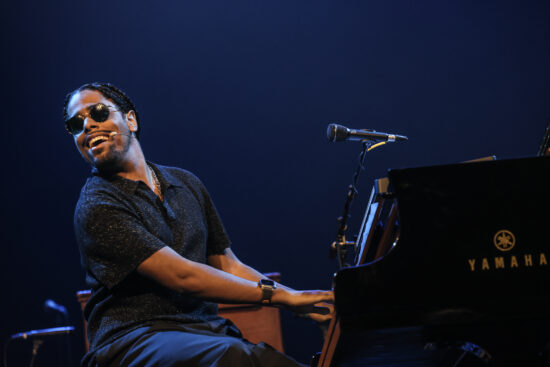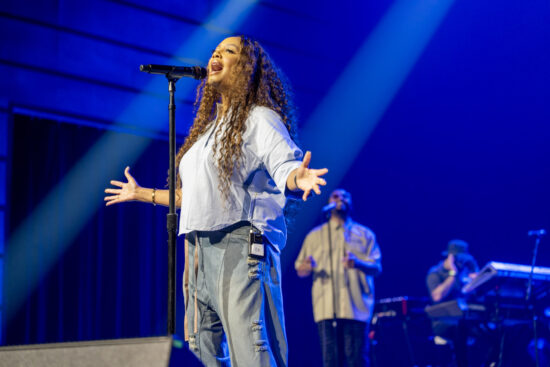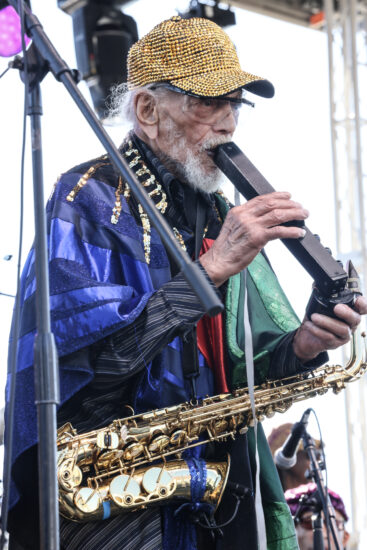The 21st annual DC Jazz Festival took place over the five days leading up to Labor Day. NEA Jazz Master Willard Jenkins, the festival’s artistic director, curated an experience that spanned the spectrum of jazz in all its stylistic breadth.
To note briefly: Armed military police were on The Wharf every day of the festival. They weren’t stopping, searching or harassing anyone, but their presence dampened the mood a bit. Some people joked about the “clear necessity” of protecting the city from “dangerous” jazz enthusiasts. But the impact was minimal overall, as these agents had been deployed for almost three weeks and were recently seen in some areas picking up litter.
Opening Night: The Hamilton Live
Most of the featured artists on opening night were stalwarts of DC’s rich jazz scene. They were assembled in a big band led by one of the area’s most esteemed pianists and educators, Allyn Johnson. The featured guest was harpist Brandee Younger, and though she played only one song, her performance made clear that the acclaim she has garnered is definitely justified.
The harp produces a gorgeous, shimmering waterfall of aural elegance unlike that of any other instrument. Because the harpist’s fingers have direct contact with the strings, even the pianist, with nearly twice as many strings, cannot match the harp’s vibrational radiance. Whether Younger is plucking an insistent ostinato, strumming firm, melodic accompaniment or improvising with soaring brightness, her command of the instrument’s capabilities is arresting.
Palisades Hub
The Marty Ehrlich Trio performed at a cozy community performance space in the northwest quadrant of the District. Ehrlich has long been regarded as a leading figure in the avant-garde, though Ehrlich himself has always rejected this pigeonholing of his music, and for good reason: It’s much more than that. This was clearly evident from the lively set by his current trio, which includes bassist John Hébert and drummer Nasheet Waits.
The trio started with a song from its latest recording, This Time (Sunnyside). The piece, “Dusk,” an Andrew Hill composition, is also the title track of a Hill album released in 2000 that Ehrlich himself played on. Ehrlich’s arrangement called upon the bass to carry the throbbing melody, as Ehrlich improvised obliquely and teasingly upon it.
Playing freely, unbounded by functional tonality or a structured rhythmic framework, is one aspect of Ehrlich’s oeuvre, and there were such moments throughout. But in a few instances, such as the soulful “Blue Boyé’s Blues,” Ehrlich and his mates summoned up a downright funky groove. The crowning moment occurred during that song, as Ehrlich sauntered over to the drumkit, turned directly to face Waits, hunched his shoulders and blasted out a blustery solo. Take that, pigeonholers!
The Anthem (The Wharf DC)
Each yearly lineup in DC includes an artist popular enough to sell out the festival’s largest venue, some more jazz-oriented than others. Last year’s headliner was Gregory Porter, who packed the place, as his popularity extends well beyond jazz enthusiasts. This year it was singer and songwriter Lalah Hathaway, with pianist Matthew Whitaker as the opener.

Whitaker’s music fuses jazz with other genres. His crack ensemble included guitarist Marcos Robinson, bassist Eyton Schillinger-Hyman, drummer Isaiah Johnson and percussionist Ivan Llanes. Whitaker played piano, keyboards and Hammond B-3 organ, all of which he uses effectively and affectingly. The 24-year-old is a very good pianist, but what stands out about him as a live performer is his charismatic stage presence, energy and ability to connect with the audience — qualities not always found among the ranks of technical virtuosi.
Lalah Hathaway, one of the most gifted vocalists of her generation, possesses impressive range and remarkable versatility, projecting both strength and tenderness even within a single song. As a performer, composer and lyricist she blends elements of R&B, jazz, soul and gospel to create her own unique style. Her stories cover a broad range of emotions, from the passionate love of “For Always” and “Let Me Love You” to the admonition of “When Your Life Was Low” and the triumph and self-affirmation of the powerful “I’m Coming Back.”

Hathaway also performed a medley of songs by Anita Baker — “Angel,” “Same Old Love” and “Rapture” — giving a nod to one of her influences. Her cover of Luther Vandross’s “Forever, For Always, For Love” was quite well done, though it didn’t stray far from the original. The takeaway was that Lalah Hathaway’s voice is difficult to categorize but nearly impossible not to like.
The Transit Pier
One of the highlights of the festival is the DCJazzPrix competition, which provides exposure and support for up-and-coming jazz ensembles. The winning band receives a $15,000 grand prize and a yearlong engagement with the festival organization in business mentorship, career guidance and the opportunity to perform on a main stage at the following year’s festival.
Last year’s winner was a quartet led by tenor saxophonist Hiryu Tirfe. Prior to forming his own band, Tirfe, whose parents are immigrants from Eritrea, played with a broad range of prominent artists including The Roots, H.E.R., Patti LaBelle and Wyclef Jean. He’s known for his intense work ethic, reflected in the title of his first recording, 10,000 Hours.
The first and most notable thing about how the band plays is its sheer power. It’s almost scary. Really. One wonders how its members have the physical stamina to play more than two or three songs. Tirfe plays his instrument with the strength, velocity and searing intensity of no one else I can think of, yet it appears almost effortless. He was joined by pianist Keith Phelps, bassist Sandy Eldridge and drummer Lionel Forester.
The group’s music can best be described as advanced hard bop, skirting the edges of avant-garde, with harmonic complexity and a stunning virtuosity on the part of all of its members. They swing, viciously, yet Tirfe’s engaging demeanor with the audience reveals him as a young man of warmth, humility and a firm self-assuredness.
Union Stage
Todd Marcus plays one the most awkward and challenging of the woodwind instruments, the bass clarinet. It requires more air and breath control than a saxophone, and the mouthpiece is larger, usually requiring an adjustment of the player’s embouchure. Though it’s primarily made of grenadilla (African Blackwood), it’s heavier than an alto saxophone. Yet Marcus is a bass clarinetist of formidable technical prowess and one of the few jazz musicians to play it exclusively. Not only is he an innovative instrumentalist, his unique original compositions successfully fuse American jazz with elements drawn from his mixed Egyptian heritage.
Marcus’s set displayed a complete command of his instrument on standards and on his own music. One highlight was his stirring cover of Irving Berlin’s “How Deep Is the Ocean,” beginning quietly with Marcus and just bass accompaniment. The piano and drums slipped in, quickening the tempo, finally launching Marcus to a blazing solo. One of his compositions, “Pandemic Blues” has a distinctive Arabic sound rooted in maqamat, a melodic framework common in Egyptian music. The emotional depth and stunning originality of Marcus’s music make it well worth investigating.

District Pier
Of all of the many exceptional performances in DC, none could match the mind-blowing experience of seeing 101-year-old Marshall Allen, newly minted NEA Jazz Master, and the Sun Ra Arkestra landing in DC to spread a message of astral spirituality to the inhabitants of a planet in desperate need of intergalactic healing power.
In addition to alto saxophone, Allen plays EWI (electronic wind instrument) that sounds something like a theremin. The 17-member band includes longtime members, Knoel Scott on baritone saxophone and George Gray on drums. Tara Middleton, one of the few female instrumentalists to play in the band, acts as primary vocalist and violinist.
The tunes all ran together, but snippets of the Arkestra’s best known songs were discernible, such as “Space Is the Place,” “We Travel the Spaceways” and “Moonship Journey.” Everyone wore costumes, mostly with an Ancient Egyptian or Afrofuturist theme, and a dancer added to the visual spectacle. The crowd-pleaser, as with every Arkestra performance, occurs when the band ambles into the audience while still playing their instruments, channeling the spirit of a New Orleans second line. It was the height of what festival CEO Sunny Sumter called a five-day “jazz occupation.” JT
